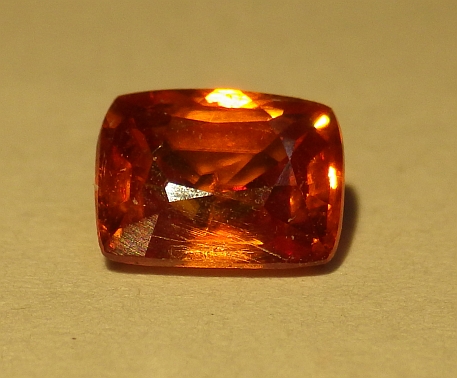
The type sample of kyawthuite
Anthony R. Kampf
Mineral Sciences Department, Natural History Museum of Los Angeles County
900 Exposition Blvd., Los Angeles, CA 90007, U.S.
George R. Rossman, Chi Ma
Division of Geological and Planetary Sciences
California Institute of Technology, Pasadena, CA 91125
Peter A. Williams
School of Science and Health,
University of Western Sydney
Locked Bag 1797,
Penrith, NSW 2751, Australia
ABSTRACT
Kyawthuite, Bi3+Sb5+O4, is a new gem mineral found as a waterworn crystal in alluvium in the Chaung Gyi valley, about 7 km west of Mogok township, Pyin-Oo-Lwin district, Mandalay division, Burma (Myanmar). Its description is based upon a single sample, which was faceted into a 1.61-carat gem. Although it was discovered in alluvium, its composition suggests that it formed in a pegmatite. Kyawthuite is monoclinic, space group I2/c, with unit cell dimensions a = 5.4624(4), b = 4.88519(17), c = 11.8520(8) Å, β = 101.195(7)°, V = 310.25(3) Å3 and Z = 4. The color is reddish orange and the streak is white. It is transparent with adamantine luster. The Mohs hardness is 5½. Kyawthuite is brittle with a conchoidal fracture and three cleavages: {001} perfect, {110} and {-110} good. The measured density is 8.256(5) g/cm3 and the calculated density is 8.127 g/cm3. The mineral is optically biaxial with 2V = 90(2)°. Using the 2V, retardation (γ – α = 0.156) and nav from the Gladstone-Dale relationship, the predicted indices of refraction are α = 2.194, β = 2.268, γ = 2.350. The dispersion could not be observed, the pleochroism is 26 imperceptible and the optical orientation is X = b; Y ≈ c; Z ≈ a. Electron microprobe analyses (average of 9), with Sb2O3 and Sb2O5 apportioned in accord with the structure, provided: Bi2O3 50.64, Sb2O3 6.90, Sb2O5 42.44, Ta2O5 0.52, total 100.50 wt%. The empirical formula (based on 4 O apfu) is (Bi3+0.82Sb3+0.18)Σ1.00(Sb5+ 0.99Ta5+ 0.01)Σ1.00O4. The Raman spectrum is similar to that of synthetic Bi3+Sb5+O4. The infrared spectrum shows a trace amount of OH/H2O. The eight strongest powder X-ray diffraction lines are [dobs in Å(I)(hkl)]: 3.266(100)(-112), 2.900(66)(112), 2.678(24)(200), 2.437(22)(020,-114), 1.8663(21)(024), 1.8026(43)(-116,220,204), 1.6264(23)(-224,116) and 1.5288(28)(312,-132). In the crystal structure of kyawthuite (R1 = 0.0269 for 593 reflections with Fo > 4σF), Sb5+O6 octahedra share corners to form checkerboard-like sheets parallel to {001}. Bi3+ atoms, located above and below the open squares in the sheets, form bonds to the O atoms in the sheets, thereby linking adjacent sheets into a framework. Bi3+ is in lopsided 8 coordination, typical of a cation with stereoactive lone electron pairs. Kyawthuite is isostructural with synthetic β-Sb2O4 and clinocervantite (natural β-Sb2O4).

last revised 22-Apr-2019